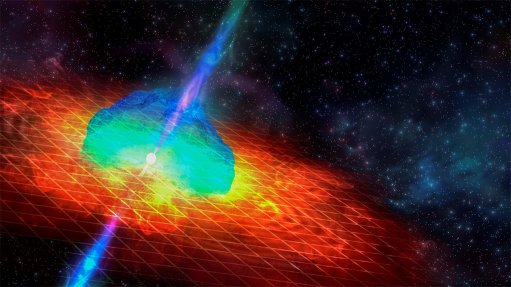
Computer model of the kilonova event and associated GRB
Photo by: University of Birmingham
An international team of scientists, based in the US, the UK and the Netherlands, has determined that a gamma-ray burst (GRB) detected a year ago was caused by a rare event, known as a kilonova. A GRB is an immensely powerful explosion which can range in duration from a few milliseconds to several hours.
By far the majority – at least 90% -- of GRBs are caused by supernovae, during which the core of a massive star collapses (into a neutron star or even a black hole) while triggering a massive explosion of its outer layers. A kilonova, however, is created by the collision of two neutron stars or of a neutron star with a black hole. Kilonovae may account for up to 10% of GRBs.
The GRB concerned, designated GRB 211211A, was detected by the US National Aeronautics and Space Administration’s Neil Gehrels Swift Observatory and the Fermi Gamma-ray Space Telescope, in December last year. The team of scientists which examined the data are based at Northwestern University in the US, the University of Birmingham and the University of Leicester, both in the UK, and Radboud University in the Netherlands. The team was led by postgraduate (PhD) student Jillian Rastinejad at Northwestern.
GRB 211211A had a duration of about one minute, which is relatively long for a GRB. That duration would normally suggest a supernova as its cause. But this GRB produced too much infrared light, was a lot fainter and faded faster than would be the case in a supernova event.
“A [GRB] is followed by an afterglow that can last several days,” explained University of Leicester postdoctoral researcher Dr Gavin Lamb. “These afterglows behave in a very characteristic manner, and by modelling them we can expose any extra emission components, such as a supernova or a kilonova.”
It was this research that showed that GRB 211211A had to be caused by a kilonova. It is the first kilonova to be discovered without the detection of the gravity waves that they also produce. At a distance of one-billion light years, it is also the closest kilonova yet found.
Kilonovae are the events which produce heavy elements such as gold and platinum. “We found that this one event produced about 1 000 times the mass of the Earth in very heavy elements,” reported University of Birmingham Associate Professor Matt Nicholl. “This supports the idea that these kilonovae are the main factories of gold in the universe.”